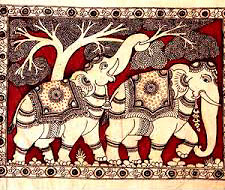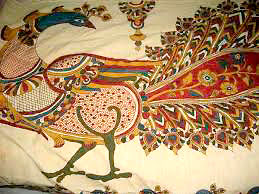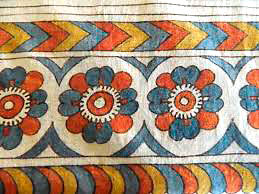
ANCIENT INDIAN ARTFORM TRAVELED THE TRADE ROUTES

 The ancient Indian art of kalamkari originated about 3,000 years ago. It derives its name from kalam meaning pen, and kari meaning work, literally pen-work. The kalamkari artist uses a bamboo or date palm stick pointed at one end with a bundle of fine hair attached to this pointed end to serve as the brush or pen.
The ancient Indian art of kalamkari originated about 3,000 years ago. It derives its name from kalam meaning pen, and kari meaning work, literally pen-work. The kalamkari artist uses a bamboo or date palm stick pointed at one end with a bundle of fine hair attached to this pointed end to serve as the brush or pen.
The earliest such paintings were drawn on cotton fabric only, but now they’re done on silk and other materials as well. The Kalamkari art includes both printing and painting, using colors made from organic sources. Most colors are prepared using parts of plants such as roots and leaves along with mineral salts of iron, tin, copper, alum, etc., which are used as mordants. Numerous forms and styles of this type of painting are found throughout the Indian subcontinent.
History
In ancient India, the art of painting using organic colors and dyes was very popular, but this style of painting originated at Kalahasti (80 miles north of Chennai) and at Masulipatnam (200 miles east of Hyderabad). The paintings depicted Hindu deities and scenes from Hindu mythology. In Masulipatnam — a Muslim region — the weavers used block printing whereas artists from Kalahasti painted Hindu mythological scenes.
Styles of Kalamkari paintings
-
Masulipatnam kalamkari: Owing to Muslim rule in Golconda, the Masulipatnam kalamkari was influenced by Persian motifs and designs, widely adapted to suit their taste. The outlines and main features are done using hand-carved blocks. The finer details are later done using the pen.
-
Sri Kalahasti Style: The Kalahasti tradition, which developed in the temple region, mostly concentrated on themes from Hindu mythology, epics (Ramayana, Mahabharatha), images of Gods and heroes.
-
Karrupur Style: Karrupur is a style of kalamkari that developed in the Thanjavur region during the Maratha rule. The kalamkari work was a further embellishment to the gold brocade work in the woven fabric, which was used as saris and dhotis by the royal family during the period of Raja Sarfoji and later Raja Shivaji.
 Use of kalamkari in trade
Use of kalamkari in trade
The traders and merchants across the world used kalamkari paintings as currency in the spice trade. There was a very high demand of spices such as nutmeg, clove and pepper as well as aromatic woods and oils, available almost exclusively in parts of Southeast Asia and Indonesia. The Southeast Asian and Indonesian traders demanded Indian textile in form of kalamkari paintings for ritual and ceremonial use.
Kalamkari textiles took many forms depending on their intended market. Prayer rugs, canopies and door covers painted with meharab designs, animal forms and floral motifs were made for the Middle-Eastern market. Tree-of-life bedcovers and dress material that resembled crewel work was painted for the European market. On the other hand, patterned hip and shoulder wrappers and narrative wall hangings were traded to the Southeast Asian market and material for robes and jackets were sent to East Asia.
Names associated with kalamkari
The artists who worked on the kalamkari painting scrolls were known as Jadupatuas or Duari Patuas. This can be translated to “magical painters.” European trading merchants, however, gave the process their own names which included the more familiar chintz which came from the British. The Dutch called it sitz whilst the Portuguese referred to it as pintado.
 Technique
Technique
The process is very slow and vigorous. The kalamkari goes through a process of resist-dyeing and hand printing. There are many treatments involved before and after the paintings are done. The colors change depending on the treatment of cloth and quality of mordant. Every step in the process is painstakingly done and with perfection for the flourishing market in and outside of India.
Children can create kalamkari motif designs using thin permanent marker on handkerchief or tote bags, envelopes, cards, cotton cap or any fabric. After drawing the design with the marker just paint with fabric colors. Don’t forget to use natural look colors such as yellows, greens and blues.
Call for Art and Open Invitation
Shyama’s Art is going to hold an art exhibit called “Square Art 2015” in January at Carrollwood Cultural Center. The exhibit will be through the month. A reception and award ceremony will be Jan. 24, 2 to 5 p.m. This is an open call for artists of all ages. Deadline is the end of November. All the artwork must be on a square canvas. If done on paper, it must be framed and ready to hang. Registration fee is $45. Shyama’s Art will distribute trophies and certificate to all the participants. Contact Shyama at (813) 843-6784 for more information.
This is my personal invitation to all those who are interested in arts. It’s free. Come and enjoy the art because it is done by Heart.
Remember: When it’s from HEART, it’s ART.
Shyama’s Art Gallery & Studio is at 10217 N. Woodmere Road, Tampa. For information, call (813) 843-6784 or visit www.shyamshyama.com
Music
‘CHANTS’ ALBUM IS MUSIC TO THE SPIRITUAL SOUL

In our chaotic world, we often struggle to seize a few private moments of tranquility. A little time to regain composure and balance is required to face our daily challenges. Music can play a significant role in restoring serenity and perhaps even serendipity to our agitated hearts and minds. It’s crucial, though, to pick the right kind of music. Spiritual chants and hymns can be calming not just to religious listeners but agnostic ones as well. I often seek refuge in such soothing music to alleviate frayed nerves or to just elevate thought to a higher transcendental plane. The ease to access, download or buy this uplifting music is our good fortune.
One such helpful music album is “Chants of India,” conceived, composed and conducted by world-renowned exponent of the sitar, the late Bharat Ratna Pandit Ravi Shankar. The album consists of 16 beautifully performed chants, hymns and melodies. The rich music is an amalgam of a symphony of North-South Indian classical instruments along with a soaring chorus of male and female vocalists. Western instruments are blended in at opportune moments: the sitar, veena, violin, bansuri flute, sarod, santoor, tabla, pakhawaj, mridanga, Cello and vocals come together to create an experience that both energizes and relaxes the music lover.
These chants have been selected from Hindu religious scripture and text – the Vedas and Upanishads in the ancient and grandiose language of Sanskrit. But the message of peace, wisdom and love they convey are universal. Pandit Ravi Shankar himself has provided vocals as well as his dynamic star playing to some of the compositions. The “Vandana Trayee” chant to invoke Lord Ganesha in raaga Hamsadhwani transitions to the next piece “Sarve Sha” – which pleads for peace and happiness in the entire cosmos. Another well-known hymn “Asato Maa” (Lead me from darkness to light) aptly uses the cello, veena, and santoor along with a solemn vocal rendition. This hymn is composed in raaga Bilaskani Todi. The fourth track “Omkaaraya Namo Namaha,” based on the lilting raaga Yaman, is followed by “Sahana Vavatu” performed in the morning melody Ahir Bhairav.
“Veena-Murali” is a short instrumental piece in raaga Bhoopali (Mohana). “Maha Mrityunjaya” is an ode to the one who has conquered death: Lord Shiva. The mere act of listening to the chanting of these shlokas is believed to give you spiritual strength and raise the soul’s divinity. “Vedic Chanting” of universal truths is the kind we often get to hear tunefully done by priests at South Indian temples, which have remained relatively unchanged by the onslaughts and invasions that ravaged Northern India through history. Recitation from the Bhagwat Geeta is done by Maestro Pandit Ravi Shankar himself. The “Mangalam” chant spreading good vibes to all of Creation is followed by “Hari Om,” a hymn based on raaga Bairagi.
The shloka “Poorna Mada”uses the instrument of santoor and bansuri to complement the majestic singing. The 13th track of the album, “Prabhuji,” is an innocent endearing bhajan (devotional composition) sung by Pandit Ravi Shankar and chorus. It is an entreaty to the Almighty to protect and bless the erring devotee. More Vedic chanting, Swara Mantra and the poignant powerful Gayatri Mantra complete this classic music album. “Chants of India” makes for a fulfilling musical and spiritual experience.
Lavanya Dinesh, an accomplished performer and teacher of Hindustani classical vocal music, lives in Tampa. She can be reached at [email protected]